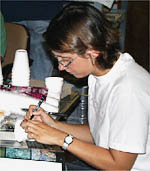|
|
TODAY'S WEATHER
Making Maps of the Seafloor Finally, some rain! For the first time in several weeks, RV Melville got a freshwater wash this morning thanks to numerous passing rain squalls that turned the sky gray and the seas choppy. It was a welcome change from the nearly continuous heat and sun we've experienced in the tropics during this expedition. As I write this Journal, we are hauling the sonar fish up to the surface, having completed the last survey line. It will be on board by 2300 hours, and then we will dredge for young lava based on the maps we’ve been making the past few days.Have you ever thought about what it takes to make a map? First, you must know exactly where you are every second of the time you are collecting the data. If you don't know where you are, you can’t make a good map! While we are surveying, we continuously record the ship’s navigation and location, and also that of the mapping system we are using. Scott White and Uta Peckman then go through all the navigation data and analyze it to make sure all the locations are correct. Once this is done, Steve Gegg, Julia Getsiv and Greg Kurras match the sonar data with the navigation data. They do this using the time of each data point in the navigation and sonar files. They then can make detailed images of the seafloor terrain. Remember that the DSL-120 sonar images can resolve features on the seafloor just a bit larger than your dining room table -- pretty amazing considering the seafloor is 3400 meters below us! Once we have the DSL-120 sonar images of the seafloor and the multibeam bathymetry maps that Uta Peckman produces -- the fun begins! We put all the maps and images on a light table in the Main Lab. A light table is a table with a glass top with lights inside. With the lights on, you can overlay one type of map over another and see through them. In this way, we can relate the seafloor elevation to the seafloor features that show up on the DSL-120 data. We then try to figure out where recent volcanic eruptions have occurred. Based on our analysis of the maps we have made of the Galapagos Rift, we have selected three dredge targets to collect samples of seafloor lava. While we are sampling, the WHOI Deep Submergence Operations Group will switch the fiber optic cable from the DSL-120 to the Argo II imaging system. By tomorrow afternoon, we should have rocks to look at -- hopefully, they will be very fresh! Then we’ll send Argo II down to the bottom of the ocean to collect images of the seafloor for the final time on this expedition!
|
|||||||||||||||||||||||||||||||||||||||||||||||||||||||||||||||||||||||||||||||||||||||||||||||||||||||||||||||||||||||||||||||||||||||||||||||||||||||||||||||||||
© 2010 Dive and Discover™. Dive and Discover™ is a registered trademark of
Woods
Hole Oceanographic Institution




